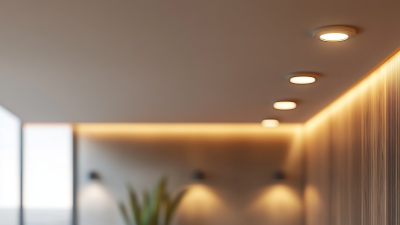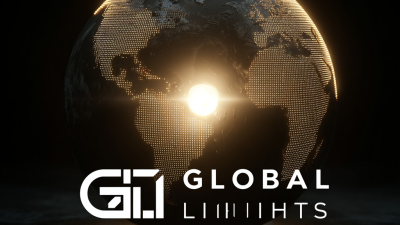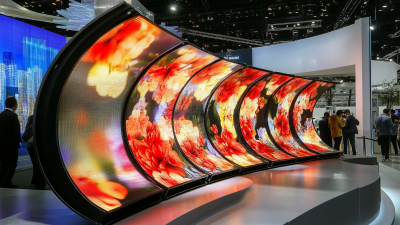The Evolution of Recessed Lighting for Modern Spaces
 Recessed lighting has undergone a significant transformation over the years, emerging as a preferred choice for modern spaces. According to a report by the American Institute of Architects, over 65% of architects specified recessed lighting in their recent designs, highlighting its versatility and aesthetic appeal. This type of lighting not only enhances the ambiance of interiors but also optimizes space utilization, making it ideal for both residential and commercial applications.
Recessed lighting has undergone a significant transformation over the years, emerging as a preferred choice for modern spaces. According to a report by the American Institute of Architects, over 65% of architects specified recessed lighting in their recent designs, highlighting its versatility and aesthetic appeal. This type of lighting not only enhances the ambiance of interiors but also optimizes space utilization, making it ideal for both residential and commercial applications.
As technology advances, the integration of energy-efficient LED options has further bolstered the popularity of recessed lighting, with the U.S. Department of Energy estimating that LED fixtures use at least 75% less energy than traditional incandescent bulbs. In this blog, we will explore the evolution of recessed lighting, examining its design innovations, installation techniques, and the myriad of options available to create the perfect atmosphere in any modern space.
The Historical Background of Recessed Lighting in Interior Design
The historical background of recessed lighting in interior design can be traced back to its emergence as a functional and aesthetic element within modern homes. Initially, recessed lighting was primarily utilized to save space and provide a clean look, allowing designers to focus on other aspects of interior decor. Over the years, it has evolved from simple can lights to sophisticated, integrated systems that enhance both ambient and task lighting. According to the latest market report, the global recessed lighting market size is projected to grow from USD 33.08 billion in 2025 to an impressive USD 84.96 billion by 2033, underscoring its growing popularity among homeowners and designers alike.
As we look ahead, the dynamics of recessed lighting are shifting due to changing consumer preferences and design philosophies. Designers are moving away from the traditional overhead lighting commonly associated with stark, utilitarian spaces towards a more layered lighting approach. This shift caters to the desire for warm, inviting atmospheres in homes, as evidenced by findings that indicate a preference for recessed lighting combined with statement fixtures to create character in spaces like kitchens. The trend anticipates an increased incorporation of retro styles alongside contemporary designs, signaling a renaissance in how recessed lighting is perceived and implemented in modern interior spaces.

Current Market Trends: The Growing Popularity of Recessed Lighting Solutions
Recessed lighting has become increasingly popular in modern interiors, aligning with current market trends that favor sleek, minimalist aesthetics. As homes shift towards maximizing space and creating subtle layers of light, recessed lighting solutions provide an effective means to achieve both functional and decorative purposes. Designers are embracing this trend, integrating these fixtures into diverse spaces, from living rooms to kitchens, where they enhance the overall ambiance without overwhelming the design.
Looking ahead to 2025, the conversation around recessed lighting will likely continue to evolve. Industry experts suggest a move away from traditional fixtures, with homeowners opting for more innovative solutions that support contemporary living trends. For instance, as bold pendants gain traction, recessed lighting will still play a crucial role in creating an inviting atmosphere, allowing for multiple lighting sources that can underscore character and style. The preference for layered lighting will ensure that recessed options remain relevant, promising a bright future in modern home design.
The Evolution of Recessed Lighting for Modern Spaces
This chart illustrates the growing popularity of recessed lighting solutions over the years, highlighting the percentage share of different lighting types in modern spaces from 2018 to 2023.
Technical Innovations: Advancements in LED Technology for Recessed Lighting
The advancement of LED technology has revolutionized recessed lighting, bringing significant improvements in efficiency and versatility. According to the U.S. Department of Energy, LED lighting utilizes at least 75% less energy than incandescent lighting while lasting 25 times longer. This not only reduces energy bills but also minimizes environmental impact, making LED recessed lights a sustainable choice for modern spaces.
Recent innovations have introduced features like adjustable color temperatures and smart controls, allowing users to customize lighting to fit their needs. A report by Navigant Research highlights that the global smart lighting market is expected to grow significantly, with recessed LED lighting playing a pivotal role. Integration with smart home systems transforms the way we interact with our living spaces, providing convenience and an enhanced ambiance fit for any occasion.
Furthermore, advancements in heat management technology have improved the longevity and performance of recessed lights. By incorporating better thermal management systems, manufacturers can ensure stable performance even in compact spaces. The result is a product that not only looks great but also functions efficiently, redefining how recessed lighting is utilized in contemporary residential and commercial designs.
The Evolution of Recessed Lighting for Modern Spaces - Technical Innovations: Advancements in LED Technology for Recessed Lighting
| Feature | Traditional Recessed Lighting | LED Recessed Lighting |
|---|---|---|
| Lifespan | 1,000 - 5,000 hours | 15,000 - 50,000 hours |
| Energy Efficiency | 10-20 lumens per watt | 80-100 lumens per watt |
| Heat Emission | High | Low |
| Color Range | Limited | Wide spectrum available |
| Dimming Capability | Requires special dimmers | Compatible with most dimmers |
| Initial Cost | Lower | Higher, but cost-effective over time |
Design Applications: How Recessed Lighting Enhances Modern Space Aesthetics
Recessed lighting has evolved into a key design element that enhances the aesthetics of modern spaces. This type of lighting is seamlessly integrated into ceilings, providing a clean and contemporary look that complements various interior styles. By minimizing visual clutter, recessed fixtures allow for the showcasing of architectural features, artwork, and furniture, creating a harmonious balance within a room. Designers can strategically place these lights to highlight focal points, providing both functionality and flair.
Moreover, the versatility of recessed lighting makes it suitable for a wide range of design applications. In living rooms, soft, warm light can create an inviting atmosphere, while brighter lights in kitchens add to the functional workspace. Adjustable fixtures can also be used to change the mood, from vibrant gatherings to relaxed evenings. With advancements in LED technology, homeowners now have access to energy-efficient options that offer customizable brightness and color, further enhancing the adaptability of recessed lighting in modern interiors. This evolution not only elevates the aesthetic appeal but also supports the trend of creating personalized, multifunctional spaces.
Sustainability Considerations: Energy Efficiency and Eco-Friendly Solutions in Recessed Lighting
The modern approach to recessed lighting goes hand-in-hand with sustainability considerations, where energy efficiency and eco-friendly solutions are at the forefront. As designers and homeowners become increasingly aware of their environmental impact, the demand for lighting solutions that minimize energy consumption has risen dramatically. LED recessed lights are a prime example of this shift. They not only consume up to 75% less energy compared to traditional incandescent bulbs but also boast a significantly longer lifespan, reducing both waste and the need for frequent replacements.
In addition to energy efficiency, the materials used in recessed lighting fixtures also play a critical role in promoting sustainability. Many manufacturers are now focusing on eco-friendly options, utilizing recycled and recyclable materials in their designs. Moreover, smart lighting technology enables users to control their recessed lighting more efficiently, allowing for automatic dimming and scheduling based on real-time usage. This innovation not only enhances energy savings but also contributes to creating a sustainable living environment. By prioritizing these eco-friendly solutions, recessed lighting can evolve into a vital component of modern, sustainable spaces.

Related Posts
-

Mastering the Art of Selecting Recessed Downlights for Your Space
-

How to Maximize Energy Efficiency with Recessed Lighting: Insights and Tips from Industry Data
-

Global Market Insights for Best Recessed Lighting Toward 2025 and Beyond
-

The Ultimate Guide to Designing and Implementing Led Custom Light Solutions for Your Business
-

Top Strategies for Maximizing Energy Efficiency with Exterior Led Lighting
-

Global Market Outlook for Flexible Led Innovations and Future Trends in 2025
